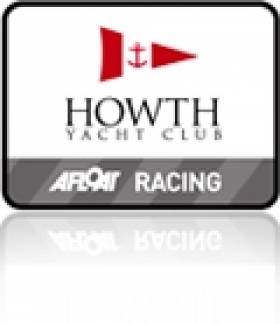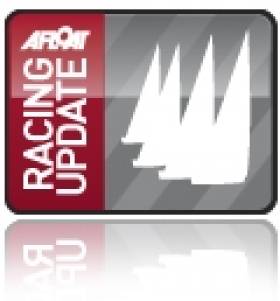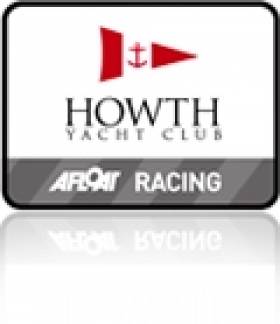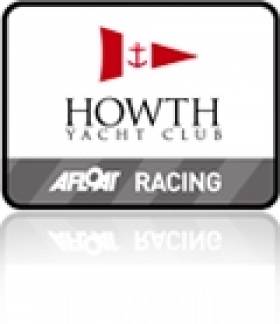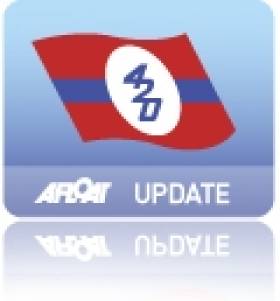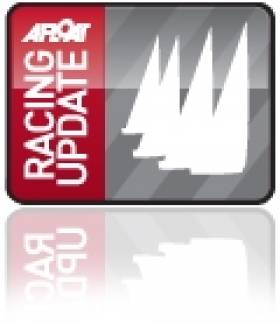Displaying items by tag: Howth Yacht Club
Howth Yacht Club's Double–Hander On Target for Little & Large Boats
#hyc – The new one-day Howth YC Double-Hander, with sponsorship from Aqua Restaurant and shaping its course round the islands and rocks of Fingal plus the Kish Lighthouse, struck a successful chord for its inauguration yesterday (Saturday August 23rd). Brainchild of Simon Knowles, who discovered his enthusiasm for double-handed challenges in last year's Dun Laoghaire-Dingle Race, it got off to a fine inauguration with 33 starters writes W M Nixon.
A fleet which had been comfortably on the 22 mark at mid-week surged on the day to these 33 boats, most of them from the host club, and ranging in size from Roy Dickson's Corby 25 Rosie and Vincent Gaffney's Laser 28 Alliance II up to craft like Stephen's Harris's First 40.7 Tiger and Stephen O'Flaherty's Spirit 54 Soufriere.
They were divided into Spinnaker and White Sail, with each division having both IRC and the Howth variant on the ECHO handicap. With the morning's crisp and sunny nor'west breeze forecast to fade as the day went on, and with a big tide hitting High Water an hour and a half after the 1000hrs start, it was reckoned the best option was north to Lambay and then southeast to the Kish, which would allow for the new flood in late afternoon to bring in stragglers to finish where they'd started, at the old HYC line on Howth's East Pier.
It was a reaching start, which seems to be the best option with double-handed events, and the non-spinnaker division first away saw Stephen Harris read it to perfection with Tiger. By the time they were shaping their course up the east side of Ireland's Eye the dark blue First 40.7 was well out on her own.
Things were closer in the more numerous spinnaker division, with David Kelly in the J109 Storm, Ross McDonald in the X332 Equinox, Jonny Swann in the classic Humphreys Half Tonner Harmony, and Ian Dickson in Rosie hitting the line together at the front of the fleet, with Equinox getting the best of it to be first around the turning mark.
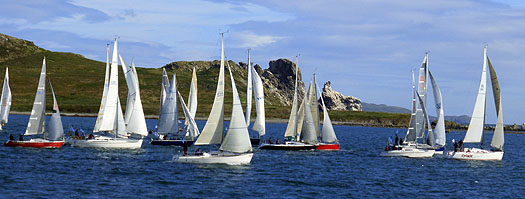
A reaching start is the preferred option for Double-Handed events. In the spinnaker division, Storm, Equinox, Alliance II and Rosie have the best of it. Photo: W M Nixon
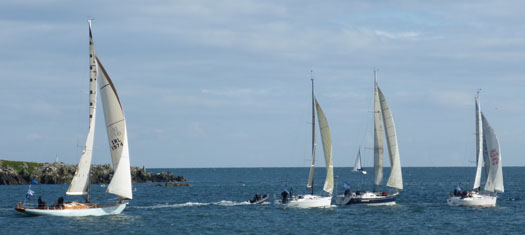
Stately and conservative perhaps, Soufriere plays it safe at the start, but very soon was milling her way past the fleet. Photo: W M Nixon
However, the queen of the fleet Soufriere was not only looking very well in the morning sunshine, but after an understandably conservative start, Stephen O'Flaherty and David Cagney wound the big girl up, and in conditions made for her, she marched through the fleet on the long leg to Lambay, and then consolidated her lead on the even longer run down to the Kish in the sluicing ebb.
But the zing was going out of the wind, and by the time the tailenders got to the Kish it had evaporated altogether - some reported being becalmed for nearly an hour before a faint new breeze began to make in from the east. Soufriere meanwhile was still on the pace closing in towards the Nose of Howth, her crew working so hard you couldn't help but think that it would be more fair if boats in these short-handed events were allowed to carry a percentage of their racing crew – something like 33% would be more equitable - instead of everyone racing with just two regardless of boat size.

Nearly there.....Soufriere gets close to the finish in the very last of the original breeze. Photo: W M Nixon
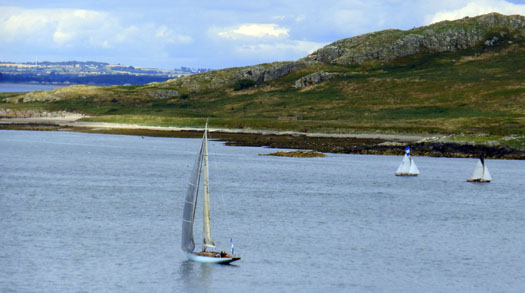
With the last of the ebb still against her, Soufriere has stopped very near the line, even though the two Howth 17s are still finding breeze close in to Ireland's Eye. Photo: W M Nixon
Be that as it may, Soufriere nearly made it, but the wind gasped its last within less than half a mile of the finish. Eventually, she got across in a little local zephyr from the southwest at 15.10.02, which was good going for the day that was now in it, and it looked better and better as the boats still at sea weren't getting anywhere much.
However, the new easterly sharpened just that tiny bit, and the Swann/Freyne team on Harmony were perfectly placed to take full advantage of it, heading steadily for the finish under spinnaker ahead of some much larger boats, and with the other classic Half Tonner, Dave Cullen's King One, somewhat out of it fifteen minutes astern.

Trickling in to the finish with the new easterly breeze are Colm Bermingham's Bite the Bullet. David Kelly's Storm tacking to lee northward, and Stephen Harris's Tiger leading the non-spinnaker class. Photo: W M Nixon
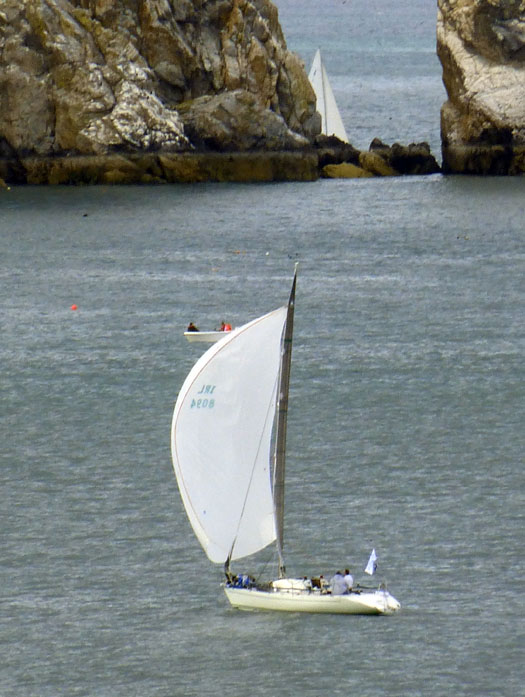 Dave Cullen's classic Half Tonner King One is going well in the easterly nearing the line, but Harmony is already finished. Photo: W M Nixon
Dave Cullen's classic Half Tonner King One is going well in the easterly nearing the line, but Harmony is already finished. Photo: W M Nixon
Harmony was in just before 4.0pm, correcting to five minutes ahead of Soufriere which nevertheless stayed in second three minutes ahead of Equinox, with Demot Skehan's MG34 Tough Nut taking fourth ahead of King One in fifth.
In the non-spinnaker class, Tiger had sailed a wellnigh faultless race, but the chips just didn't fall her way, and though she took line honours, across both handicap system the most consistent performer was Jennie O'Leary with the First 33.7 Tantrum 3, as she won under IRC and was second in the Howth/ECHO division, where Joe Carton, sailing with Mossy Shanahan in the Dehler 34 Voyager, took the honours and they also took third in IRC, the other boat in the top three in the non-spinnaker division being the McAllisters from Malahide with Force Five.
The buzz throughout this new Howth event makes a repeat next year highly likely. Indeed, the third Saturday of August 2015 is already being suggested as the logical day, as the timing of this year's event seemed to hit the spot both for regular crews, and for former shipmates to getting together to give it their best shot for a very manageable one-day reunion challenge.
Meanwhile there's no doubt but it was the weekend for women sailors at Howth. Jennie O'Leary was setting the pace in the Aqua Double-Hander, at the same time HYC were hosting the Shipman 28 Nationals and the winner was Gusto sailed by Christine Heath of Royal St George YC, and the venerable Howth 17s were also having their annual Ladies Race, where the winner was Rachel Cronin sailing Deilginis. Ironically, Rachel and her husband Paddy have just sold their own Howth 17 Gladys after many years of ownership in which they won dozens of prizes but never the Ladies Race, but Rachel has done it now, helming for the lads in Deilginis.
Howth Teams Place In Top 10 At Dennis Conner Yacht Club Challenge
#DennisConner - Howth Yacht Club took two places in the final top 10 at the sixth Dennis Conner International Yacht Club Challenge in New York City last weekend, where the honours went to South Africa's Royal Cape Yacht Club.
HYC's Team 1 made a very respectable fifth place on 43 points – only five points off the third-place Swiss squad – while Team 2 placed 10th on 67 points.
As previously reported on Afloat.ie, Howth's two teams for the event were the U25s skippered by Joseph Murphy (with Gordon Stirling, Cillian Dickson, Harry Cronin and Cian Manly) and HYC Red skippered by Simon Rattigan (Rob Kerley, Luke Malcolm, Harry O'Reilly and Sam O'Byrne).
They were among 19 amateur club teams racing in New York Harbour on boats borrowed from the Manhattan Yacht Club, sailing out of the North Cove marina at Battery Park on the southern tip of the borough.
Howth Yacht Club Double Hander Race Attracts Stellar Entry
#hyc – A solid entry list of 22 boats and counting has built up for this Saturday's inaugural double-hander at Howth Yacht Club, the brainchild of noted helmsman Simon Knowles. He so enjoyed racing two-handed in the Dun Laoghaire to Dingle last year with clubmate Colm Buckley on the Elan 333 Blue Eyes that he got to thinking how the concept might be transferred to a long day race from their home club writes W M Nixon.
The Race Report is published HERE
With sponsorship from Aqua Restaurant, which most appropriately is located at the end of Howth's West Pier in the former yacht club building, the new race has many traditional overtones, with the start at 1000 hrs being from the time-honoured shore line on the East Pier.
As for the course, it will be set on the morning of the race, and could be as long as 40 miles using the Kish, Lambay and Rockabill as turning marks. The idea has certainly rung a bell with people jaded by today's round-the-cans racing with full crews, as the entry list as of Wednesday ranges in size from Stephen O'Flaherty's Spirit 54 Soufriere at the top of the fleet, down to the smallest boat so far entered, Roy Dickson's Corby 25 Rosie.
Simon Knowles himself will be racing again aboard Blue Eyes with Colm Buckley, though as a noted Etchells 22 helm, he reckons an Etchells might make for a good outside bet in this kind of challenge. Other noted skippers down-sizing their crew include Ross McDonald with the X332 Equinox, and David Kelly of Rush with the J/109 Storm.
Having a biggish boat doesn't seem to have discouraged several entries, as Stephen Harris is in the list with the First 40.7 Tiger, while Fred McCollum is also going with the Oyster 485 Arctic Fox. Another contender of special interest is former HYC Commodore Roger Cagney with the Hanse 37 Hansebacker, better known as a fast cruiser, while the pure racing side is also well represented with craft of the calibre of Dave Cullen's top Half Tonner King One. In all, it's an eclectic entry list, and the outcome should be neatly in place before the weather deteriorates as forecast on Sunday.

The new Aqua Double-Hander at Howth may be as much as 40 miles long making turning marks of the rocks, lighthouses and islands off the Fingal coast and Dublin Bay.
Cove Sailing Club Yacht Wins Quarter Ton Cup At Howth Champs
#hyc – Top performing Cork Quarter tonner, Dom Losty's 'Illes Pitiuses' has won the seven boat Irish Quarter Ton Championships at Howth Yacht Club. High winds in Howth yesterday meant that the final day's racing in the Euro Car Parks East Coast Championships and Quarter Ton Cup was cancelled and the positions after Saturday's exciting 3 races stood as final results.
This well attended event offered the many competitors and visitors from all around the country excellent and highly competitive racing.
The Class 3 racing was dominated by the J24s including 'J Guevara', 'Scandal' and IRC and ECHO winner 'Hard on Port' skippered by Flor O'Driscoll.
Howth's Anthony Gore Grimes and his crew on 'Dux' beat Paddy Kyne's 'Maximus' by just one point in Class 2 but 'Maximus' won the ECHO prize.
The Team Trophy was won by the Class 3 entries: Hard on Port, Tiger Nathan Kirwan Trust and Anchor Challenge.
At the prize giving, event organiser Eddie Bourke thanked the race management team for their skill in managing Saturday's racing, as well as Euro Car Parks for their generous sponsorship and remarked on the terrific number of entries in what was a very successful event for the Class 2, Class 3 and Quarter Ton boats.
Full results here.
Howth 420 Pair Make Top Ten of Youth Europeans
#420 – After a good start, Howth's Robert Dickson/Sean Waddilove are in the top ten of the 420 Youth Europeans in Poland. Royal Cork's Harry Whitaker and Grattan Roberts are 13th with club mates Peter McCann and Arran Walsh in 16. The crews are part of a seven boat Irish 420 team competing.
Top 10 finishes for series leaders Hippolyte Machetti/Sidoine Dantes from France means they continue to control the leader board in first overall with 10, 3 finishes.
Ewa Romaniuk/Katarzyna Goralska move up into second on the leader board from more solid results with a 10,5 performance and rank as the top placed girls team. Seven points behind are the USA's Will Logue/Bram Brakman in third overall.
At the 2013 420 Junior Europeans Romaniuk/Goralska faltered after a strong start, but they are determined to use the past year's experience, including their career best of a bronze medal at the ISAF Youth Worlds, to finish on the podium at the 2014 420 Junior Europeans.
"We have grown up since last year and gained more experience," commented Romaniuk. "We have trained hard over the past winter to prepare for this year's Championship."
The team's bronze medal at the ISAF Youth Worlds was a perfect execution of race delivery and controlling nerves. They went into the final race in 5th overall, and with many other teams able to secure silver and bronze, the won the race and finished their second ISAF Youth Worlds appearance on the podium.
Joining the Polish as the only girls teams in the top 10 are Greece's Aikaterini Tavoulari/Fotini Koutsoumpou in 7th and Clara Addari/Arianna Perini (ITA) in 9th.
Eight nations are represented in the top 10 as the leaderboard changed hands several times today.
Two more races are scheduled on Friday 15 August to complete the qualification stage for the 2014 420 Junior European Championships. Results after tomorrow's racing will see the 108 boat fleet split into gold and silver, with 54 boats in each fleet, for the final series of 6 races. The discard kicks in after race 5 tomorrow, so some changes in the top 10 are expected. Racing for the 420 fleets is scheduled to get underway at 1130 hours on Delta course, with the yellow fleet racing first, followed by blue fleet.
420 - Results after 4 Races
1. Hippolyte Machetti/Sidoine Dantes (FRA-55096) - 17 pts
2. Ewa Romaniuk/Katarzyna Goralska (POL-55326) - 25 pts
3. Will Logue/Bram Brakman (USA-55175) - 32 pts
4. Russell Clarida/Henry Fernberger (USA-54068) - 37 pts
5. Thomas Ponthieu/Quentin Paturle (FRA-55095) – 38 pts
6. Kilian Wagen/Gregoire Siegwart (SUI-52967) – 40 pts
7. Bart Lambriex/Philip Meijer (NED-54005) - 44 pts
8. Aikaterini Tavoulari/Fotini Koutsoumpou (GRE-54484) – 45 pts
9. Frederik Eichhorst/Julius Erbach (GER-52784) – 49 pts
10. Robert Dickson/Sean Waddilove (IRL-54417) – 52 pts
Full results here
Seven Irish Teams Contest 420 Dinghy Youth Euros in Poland
#420sailing – Four Royal Cork, two Howth/Skerries combinations plus a Kinsale YC and Malahide YC team will contest the 420 and 470 Junior European Championships in Gdynia, Poland this morning.
The seven boat Irish youth sailing line up comprises Harry Whitaker and Grattan Roberts, RCYC; Peter McCann and Arran Walsh RCYC; Lizzy McDowell and Cara McDowell Malahide Yacht Club; Douglas Elmes and Bill Staunton, RCYC; and Skerries/HYC; Robert Dickson and Sean Waddilove, Howth YC/Skerries SC; Cliodhna Ni Shuilleabhain and Jil McGinley Kinsale YC and Royal Cork YC and Ewan McMahon and Colin O'Sullivan, Howth.
The two Junior European Championships are held alongside each other to support the natural transition between the 420 and 470, although the racing format and course areas are separate.
A total of 332 sailors are competing, with teams from 25 nations contesting the 420 Junior Europeans and 470 Junior Europeans. Joining the European nations are teams from Australia, Canada, Hong Kong, New Zealand and the USA.
Warm-up events for both classes has seen the 470 Class running a three-day training clinic led by world-class coach Nigel Cochrane (CAN), whilst the 420 fleet has enjoyed the Polish 420 National Championships as a training ground. The 420 National Championships gave an early taste of form with fifty-eight teams competing, including twenty-five international teams. The Nationals was won by Greece's Nikolaos Brilakis/Nikolaos Georgakopoulos and top ladies team were Poland's Ewa Romaniuk/KataRzyna Goralska in second overall.
Some of the sport's most talented youth teams are set to flex their muscles on the race tracks of Gdynia, including the 2014 470 Men Junior World Champions, 470 Women Junior World Championship podium finishers, the defending 470 Women Junior European Champions and a stellar line up of 420 sailors including medallists from the recently held 420 World Championships and the ISAF Youth Sailing World Championships.
Keeping Poland's ambitions burning strong are 38 of the nation's best young sailors, with ten teams in the 470 fleets and a fourteen-boat line-up in the 420 Class.
The 2014 420 and 470 Junior European Championships officially opened this evening at an opening followed by sailors' buffet.
470 MEN AND WOMEN
Reigning 470 Junior World Champions, Jordi Xammar/Joan Herp of Spain successfully defended their 2013 Junior World Championship title in Italy in June and are now on a quest to do the double this year and add the 470 Junior European Championship to their growing gold medal haul. After their win at the 2013 470 Junior Worlds, the pair fell short of the podium at the 2013 Junior Europeans, finishing 4th by 10 points, so are back to make amends. Competing here in Poland was a last minute decision for the pair who were on vacation and simply had an overwhelming mission to compete and try to claim the Championship medal which has so far eluded them.
"We were not planning to come, but then we decided we'd better come just to see what we could do here," smiled Xammar. "The 470 Junior Europeans has not been our Championships. We have won five other junior world titles and this is the only one we haven't won."
Predicting what will give them the edge on the race track, Xammar continued, "The wind conditions and speed are not going to be the priority here. I think more important will be tactics and strategy around the race course."
The Spanish are joined by six of the other teams in the overall top 10 from the 470 Men Junior Worlds, so an intense battle is on the cards.
In the 470 Women, defending 470 Women Junior European gold medallists Anna Kyselova/Anastasiya Krasko from the Ukraine are back to defend national pride. The pair claimed silver at the 2013 Junior Worlds, but with a raft of penalty scores at this year's 470 Junior Worlds year in Italy failed to show their true form, and didn't qualify into the Medal Race top ten 10. The pair have parked that that disappointment firmly behind them and know they can win gold here if they focus on a consistent scoreline.
Teams lining up against them include silver medallists at the 470 Junior Worlds Jess Lavery/Megan Brickwood from Great Britain and the bronze medallists Noya Bar-Am/Rimon Shoshan from Israel, These three teams, are joined by five more of the top 10 from the 470 Junior Worlds in italy.
The British pair have had a break from international competition since the Junior Worlds, focusing on work commitments and training in the UK, so are also fresh to the race track.
"We have had a good few days training out here and had some good tuning with the Canadian team," commented Lavery. "It has gone well so far and we are getting familiar with the venue and feeling happy with how we are sailing."
The 470 Men and Women will race as two separate fleets, each fleet contesting a single series of 10 races, followed by the ten-boat Medal Race final. Racing is scheduled to get underway at 1100 hours on Wednesday 13 August 2014.
420 OPEN
In the 420 fleet, there are numerous familiar faces who have headed to Poland straight from the 420 Worlds in Travemuende, Germany and are back on the race track for the 420 Junior Europeans. To ensure quality of racing, entries are limited with a strict quota of seven teams per nation, apart from the host nation who can enter 14 teams. Teams race all together, so mixed teams, men and ladies teams all up against each other.
In 2013, the 420 Ladies controlled the leaderboard, claiming gold and silver, with the men's teams surprisingly off the pace in last year's windy conditions at Pwllheli, Wales.
Lighter winds are forecast for the Championship here in Poland, but judging from today's practice race, it may be more to do with who can read the wind best as shifty conditions look set to prevail.
Spain's Silvia Mas/Marta Davila won the ladies 420 division at the ISAF Youth Worlds and are looking forward to the challenge of racing in an open fleet
"I think for me it is more fun," laughed Mas. "It is a different thing just sailing with just girls compared to mixed. In the lighter winds the girls all do better, but we drop down when the wind picks up. I think it is really fun to sail all together."
"It is a bit shifty and the waves are quite difficult, particularly on starboard," she continued. "But it is the same for everybody."
The summer has been a gruelling back to back schedule of Championships, which take their toll.
"I am a bit tired," said Mas. "But I am feeling OK as although I have raced lots of Championships I have learnt a lot."
Also amongst the pre-race favourites will be the silver medallists at the 420 Worlds, Hippolyte Macheti/Sidoine Dantes of France who were also honoured as the top team placed team aged 18 and under and crowned Junior 420 World Champions.
As well as the Greek winners of the Polish 420 National Championships, local 420 team Ewa Romaniuk/KataRzyna Goralska will also be amongst the frontrunners.
Romaniuk/KataRzyna Goralska dominated during the early stages of the last year's 420 Junior Europeans, before struggling to maintain consistency and finishing 11th overall. But 2013 was a different game, as it marked their first season together. Rock forwards 12 months and the pair have far more experience to their credit and also secured the bronze medal at this year's ISAF Youth Worlds, up from 9th overall in 2014. They didn't compete at the 420 Worlds earlier in August, so are fresh for racing here in Gdynia.
Absent from the start line will be recently crowned 420 Ladies World Champions, Italy's Carlotta Omari/Francesca Russo Cirillo, and silver medallists Kimberly Lim/Savannah Siew who flew back to Singapore to prepare for upcoming school exams. Their absence also leaves the door open for the 420 Worlds bronze medallists Aikaterini Tavoulari/Fotini Koutsoumpou of Greece to step up. The pair gave the series leaders a run for their money in Germany and can do the same in Poland, particularly after their 7th overall at the Polish 420 Nationals.
There are numerous faces who can rise to the top from the 108 talented 420 teams competing, so expect some early leaderboard charges from Wednesday's opening three races.
Racing Schedule
Racing kicks off on Wednesday 13 August with three races scheduled for all fleets starting at 1100 hours. The 108 boat 420 Fleet have been split into two fleets, yellow and blue and will be re-seeded for each of the three days of qualification, after which they will advance through to gold and silver fleets for the final series.
The 470 Men and 470 Women are sailing a single race series in separate fleets, with 11 races scheduled followed by the top 10 Medal Race.
Howth YC & Royal Cork YC Contest Dennis Conner International Yacht Club Challenge in New York Harbour
#dennisconner – Ireland will send three teams to New York this week for the Dennis Conner International Yacht Club Challenge in New York Harbour.
Two Howth Yacht Club teams for the event are HYC's U25 team; skippered by Joeseph Murphy with Gordon Stirling, Cillian Dickson, Harry Cronin and Cian Manly and secondly: HYC Red skippered by Simon Rattigan with Rob Kerley, Luke Malcolm, Harry O'Reilly and Sam O'Byrne.
A Royal Cork team includes David Lane, Sinead Enright, Clem McElligott and Wendy McElligott.
Nineteen teams of amateur club sailors from 14 nations will come together from August 15th to 17th to compete in the Sixth Dennis Conner International Yacht Club Challenge organized by the NY Harbor Sailing Foundation. The races will take place on boats borrowed from the Manhattan Yacht Club, one of the largest community sailing organizations in the country with more than 900 members and will take place at North Cove, the mega yacht marina in Battery Park City in Lower Manhattan.
The three-day spectacular will feature a daily series of hour-long races in New York Harbour. All of the races will begin and end at Manhattan Yacht Club's floating clubhouse located in the harbor, near Ellis Island.
The NY Harbor Sailing Foundation was founded in 1994 and organises sailing programs in the harbor such as Operation Optimist, a junior sailing program for kids.
Founded in 1987, Manhattan Yacht Club has reintroduced recreational sailing to the harbour after a 60-year absence.
The 19 teams from 14 nations include:
- Manhattan Yacht Club (United States) - 2 Teams
- Club Universitario de Buenos Aires (Argentina) - 2 Teams
- Norddeutscher Regatta Verein (Germany)
- Royal Melbourne Yacht Squadron (Australia) - 2 Teams
- Nissan Marina Tokai (Japan)
- Howth Yacht Club (Ireland) - 2 Teams
- Fenerbahce Sailing Club "Team Goblin" (Turkey)
- Royal Cork Yacht Club (Ireland)
- Societe Nautique de la Baie de Saint-Malo (France)
- Royal Norwegian Yacht Club (Norway)
- Royal Hamilton Amateur Dinghy Club (Bermuda)
- Royal Danish Yacht Club (Denmark)
- Cercle de la Voile de la Societe Nautique de Geneve (Switzerland)
- Shanghai Boat and Yacht Club (China)
- Royal Cape Yacht Club (South Africa)
Commodore's Yacht Wins Howth 17 Championships
#howth17 – The weekend's Howth 17 Footers Championships was won by Brian & Conor Turvey's 'Isobel'. Winning two of Saturday's four races and following a lengthy protest hearing between 'Deilginis' and 'Rita' (the latter then being disqualified from Race 2) afforded the Isobel team a victory by one point from Peter Courtney's 'Oona' with Ian Malcolm and crew of 'Aura' collecting their bronze medals for 3rd.
The event coverage included a first race aerial vid by Skypixels featuring the fleet (above).
Ian Sheridan's 'Erica' couldn't replicate their winning form from the previous evening, but were popular winners of the Handicap Trophy. Following praise for the Class Captain Mary Faherty and her running of the event, Commodore Brian Turvey thanked the race management team and their National Race Officer Scorie Walls for an excellent series, relaying particular thanks for the great work of the mark-laying teams following their swift action in the last race in managing a 60 degree wind direction shift.
Irish Model Yacht Entry For European IOM Championships
#modelyacht – Once again there is a model yacht skipper representing Ireland at the up-coming 2014 IOM European Championships held in Lake Garda in September writes Gilbert Louis.
Jeff Kay from Howth Yacht Club will be flying the Irish flag once again. Jeff is not new to this level of competition as he represented Ireland at a number of European and World Championships over the past few years.
Probably the most experienced skipper in our fleet, Jeff has a wealth of experience in sailing (laser, squib, cruiser/racers, etc...) as well as in model boats too. He brings a great technical knowledge to the fleet because of his experience over the years of racing often in the top 20 at international events.
One important element to understand! The IOM fleet at international level is the most competitive fleet there is in model boats. It includes a number of World class sailors from national, international, World, European champions and Olympic sailors too. The fleet also includes professionals in the sailing world: be TP52 campaigns, VOR, skiffs, even from the America's cup teams, like Ian Vickers (OT USA). That is not counting on the countless top model boat skippers. The top 20 includes over 50% of former EU or World champions. So it is no break in the top 20.
Jeff will be racing a Britpop, a boat designed by Brad Gibson (AUS) which has taken the IOM world by storm. A still relatively new boat design with chines. It has already won numerous podiums around the world as well as Gold medals a the last EU and World champs. So it is already proven design – so proven in fact that a lot of other skippers will race one too.
In June Jeff travelled to the UK for one of their event and he managed 4th behind 2 former World champions and ahead of a 3rd. Not a bad performance considering we don't get as much on-the-water time as our friends across the Irish sea do. We are wishing Jeff the very best for the Europeans.
But that's not all Ireland will also be represented in the umpires as our national rules guru Gordon will be part of the teams of umpires and jury there to make sure everyone stick to the ISAF RRS rules. Gordon is also experienced as he has already been called upon for his services at previous international model boat events in France and the UK. Gordon is our most experienced model boat official in Ireland and we are lucky to have someone like him in the fleet. So on behalf of the Irish IOM fleet, Thank you Gordon and wish you the best in Italy in September.
Athough we may be small in number and not as known as other fleets, we do have quality and passionate skippers in the fleet. Jeff, Gilbert, Brian and Neill have been racing across the pond to the UK numbers of times, even winning some of the events. Team Ireland finished 2nd behind Scotland at the recently launched Celtic Trophy, and the Irish flag has been flying at a number of past European and World championships.
For the past 2 years we enjoyed a slow but progressive growth in the fleet with the addition of our Northern Ireland fleet to which Brian O'Neil has been instrumental in setting up and growing. As a result model boats are now sailing again on the Belfast Waterworks, thanks to the support of the county council who welcomed the activity and helped the club to setup. Sure we even had for the first time ever an Irish sailor a the UK A class National Championships with Brian entering the event despite being completely new to this class and with very little experience with his newly acquired A class. And it is not all about racing we have Gilbert who loves multis: he has a replica of Jet Service II of the 80's and a Mini40 trimaran which was based on the 60 Orma trimaran of the 90's. In Cork we even have a 1/10 sailing replica of Illbruck a VOR60 (have you done the math yet? Yes that's a 2.4m long boat, controlled by radio control). We also welcomed the return of Stephen Kay to the class who took a break for a few years – Like his brother Stephen is an experienced sailor and will be pushing top Irish skippers too.
For now on behalf of the Irish IOM National Class Association we thank you Jeff and Gordon and we wish you the best.
Top 20 Finish for Howth 420 Dinghy Duo at German World Champs
#420 – This year's Ulster and Connacht 420 dinghy champions Robert Dickson and Sean Waddilove finished 20th at the World Championships Travemunde, Germany.
Seven Irish crews went to the 199–boat 420 Worlds; five mens teams and two ladies. Following three days of qualifying races, two Irish teams qualified for the gold fleets, one in each mens and ladies.
The Howth YC pair posted their best result, a ninth, in the final race to earn a coveted top twenty overall in the 57–boat gold fleet.
Irish Gold fleet ladies team sailed by Clidohna Ni Shuilleabhain and Jil McGinley were 38th in the 42–boat gold fleet.
Full event website here




























